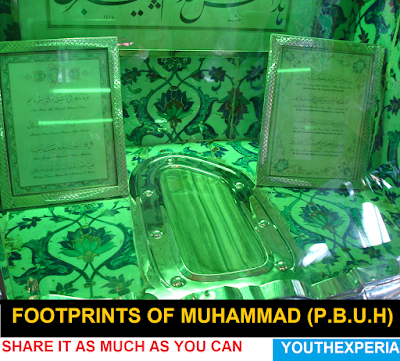The Privy Room (Has Oda) was constructed in the Inner Courtyard
in the time of Sultan Mehmed II (r. 1451-81) to serve as the private apartments
of the sultan for which purpose it was used until the middle of the 16th century. Prior to their accession to the throne, the sultans would come to this room to pray and receive homage from the Privy Room officials before leaving for the ceremony. On the walls of this two-storey structure of four basic spaces are found high-quality Iznik tiles dating to the second half of the 16th century. The silver lattice on which the throne stands in the Privy Room dates to the time of Sultan Murad IV (r. 162340). The Chamber of the Holy Relics, located within the Privy Room, contains religious objects sent to the Ottoman sultans at various times between Sultan Selim the Grim’s assumption of the caliphate in the 16th century to the end of the 19th century. The caliphate passed from the Abbasids to the Ottomans with Selim’s conquest of Mamluk Egypt in 1517, upon which event the Holy Mantle of the Prophet (Hırka-i Saâdet) was given to Selim by al-Mutawakkil III: the last Abbasid caliph. The dispatching of holy relics to Istanbul would continue thereafter, particularly during the period of increasing Wahhabi assaults on holy places and objects in the late 18th and the 19th century when such objects were gradually removed to the Chamber of the Holy Relics for greater protection. Similarly, the holy objects found in Medina were sent to Topkapı Palace for the same reason during the First World War.
A picture of the old sword
Among the most important holy relics to be collected in this way between the 16th century and the first half of the 20th century were the Holy Mantle of the Prophet; the hair from the Prophet’s beard; the reliquary in which was kept the Prophet’s tooth, broken during the Battle of Uhud on 19 March 625; and the footprints, letters, bow, and sword of the Prophet. There are also holy relics attributed to other prophets and to the companions of the Prophet Muhammad: the tray used by Abraham; the staff of Moses; the sword of David; the robe of Joseph; the swords of the Prophet Muhammad’s companions; and the shirt, mantle, praying mat, and chest of Muhammad's daughter Fatimah. In their office as Caliph of Islam, it was the duty of the Ottoman sultans to maintain and repair the Kaaba in Mecca, providing and renovating golden chandeliers, censers, rosewater vessels, oil lamps, supports and copies of the Qur’an.
|
The external external case of the cold is a box of pure gold, with Quranic verses and certificates, and the name of Sultan Abdul Aziz, which he ordered
|
Prophet Muhammad's haircuts at the Turkish Museum
As these precious objects were replaced over time, they would be brought to Topkapı Palace and the current collection of holy relics includes some of them. Additionally, the collection includes items commissioned for the Kaaba by the sultans, among them the Kaaba’s gutters, keys, gates, and the reliquaries for the Black Stone (al-Hajaru’l-Aswad), the Holy Mantle, and the Holy Beard. Also in the collection are models of the Mosque of the Prophet in Medina and the Dome of the Rock in Jerusalem; bottles of water from the Well of Zamzam made of white opal and sealed with red wax; soil from the field at Karbala; panels inscribed with Qur’anic verses; stands for the Qur’an; silver bowels; prayer rugs; censers used in the Privy Room and silverhandled brooms. Every year on the 13th and 14th days of the month of Ramadan, the Ottoman sultans would personally take part in the cleaning of the objects and tiles found in the Privy Room with rosewater dampened sponges. Should the sultan be ill or away on campaign on these days, he would appoint a deputy to take his place in this duty. Once this cleaning had been completed, the sultan and important state officials would pay a formal visit to the Holy Mantle of the Prophet on the 15th day of Ramadan. The practice of the forty aghas of the Privy Room continuously reciting the Qur'an twentyfour hours a day, before the Holy Mantle of the Prophet began when Sultan Selim the Grim had the mantle brought to the Privy Room. This practice continued when the palace was converted into a museum under the auspices of the Republic of Turkey and is currently carried out in the first section of the Treasury of the Chamberlain by “hafiz” (those who have completely memorized the Qur'an) appointed by the Presidency of Religious Affairs
The turban of the Prophet (peace and blessings of Allaah be upon him) is in one of the museums
Box with a part of Muhammad's beard. Maulâna Rumi mausoleum, Konya, Turkey
An image electronically processed for the noble Prophet's message to Hercules great Roman
|
































No comments:
Post a Comment